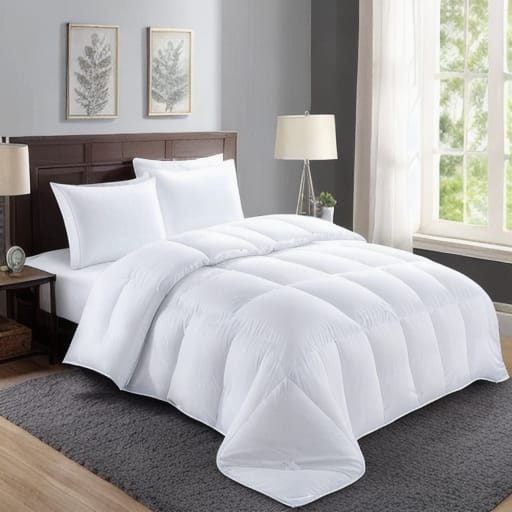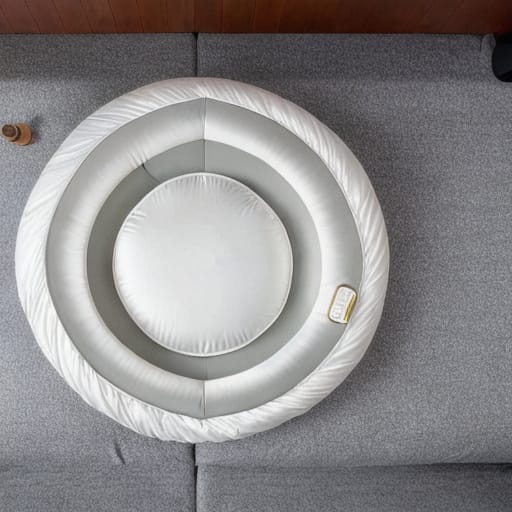Are you considering buying a down comforter but worried about it causing allergy issues? You’re not alone – many people assume feather bedding leads to more dust. But is that fact or fiction?
In this comprehensive guide, we’ll unpack whether down comforters create dust, steps you can take to limit allergens, and tips for choosing the best comforter for your needs. Read on to finally get the answers about down, dust mites, and your respiratory health.
What is a Down Comforter?
Before diving into the relationship between down and dust, let’s level set on what exactly down comforters are.
- A down comforter is a bedding item, similar to a duvet or quilt, filled with duck or goose down, which refers to fluffy feather clusters that grow close to the bodies of waterfowl to provide warmth and insulation.
- Unlike feathers which have a central quill and create structure, down clusters have higher loft and trap more air to better insulate the sleeper.
- Down comforters have been used since ancient times – references date back over 3,000 years to China where waterfowl were domesticated.
- Today, Hungary, Poland, China and the United States lead worldwide production of feather bedding like down comforters.
Down offers exceptional benefits as a bedding fill. It’s highly praised for:
- Insulation – The 3D clusters trap more air than synthetic fibers to keep warmth in and cold out. This insulation also adapts as you sleep.
- Lightweight comfort – Despite the fullness, down is extremely lightweight and allows comforters to drape well over the body.
- Durability – With proper care, down’s resilience allows it to loft back to fullness and last over 10 years.
- Breathability – Air easily circulates through down to reduce sweat and humidity.
Now that we’ve covered the basics on down comforters, let’s analyze concerns over dust and allergens.
Dust : What Exactly Is It and Where Does it Come From?
Before deciding if down comforters contribute to dust accumulation, we need to better understand what dust consists of in the first place.
Dust refers to tiny particles of debris in your home created from:
- Dead skin cells (over 70%)
- Indoor pollutants
- Textile fibers from fabric and bedding breakdown
- Pet dander
- Pest droppings and body fragments
- Pollution entering through ventilation
- More environmentally-produced particulate
Dust can become problematic due to the allergens it contains which trigger sensitivities for many people. Common culprits lurking in household dust:
- Dust mites – Microscopic spiders just 0.2-0.5 mm long that feed on flakes of dead human skin. Their bodies and waste contain proteins people inhale.
- Mold and mildew spores – Microscopic fungi living on fabric, carpet dust, or walls due to excess moisture. Spores enter airways when disturbed.
- Pet dander – Microscopic flecks of skin shed by cats, dogs, rodents, birds and other animals with fur or feathers. Saliva and urine residue may cling to dander too.
- Cockroach droppings – Particles from roach waste contain an allergen some people can react severely to.
When we breathe in these allergens during sleep or daily living, people prone to sensitivities can experience:
- Allergy symptoms like stuffy noses, sinus pressure, coughing/wheezing
- Asthma flare makes breathing difficult
- Skin irritation such as redness, itching, or hives
For allergy and asthma sufferers, dust is a prime trigger capable of creating major respiratory distress and discomfort. Their reaction depends on sensitivities and how many allergens entered airways.
Now we need to analyze if down itself contributes to dust and allergens.
The Role of Down Comforters: Do They Produce More Dust?
With a clearer grasp of what forms dust and triggers allergies, we can now address the key question:
Do down comforters create MORE dust than other bedding?
This concern typically stems from down’s origins in waterfowl, birds known to cause feather allergies. Logically, some assume bedding filled by fowl must release more feather dander and dust.
However, several factors influence how much dust down bedding creates:
1. Quality of Down Fill
- Higher quality down contains more feather filaments and fewer quills/stems from older feathers. This reduces dander-producing debris.
- Fill power (cu inches per ounce) indicates loft and density. Higher fill powers like 600-900+ trap more air with less material.
2. Processing Method
- Responsibly sourced down is washed repeatedly to remove oils, dirt and debris during processing.
- Lower quality down may retain more particulate to break down over time.
3. Age of the Comforter
- With use over 5+ years, natural down breakdown can release more dust.
- Budget quality comforters deteriorate faster.
4. Care and Maintenance
- Frequent washing removes most debris according to strict guidelines.
- Infrequent cleaning allows more accumulation inside.
With high standards in place for down quality, thorough processing methods, and proper care guidelines, allergen production can be minimized.
Down Comforters vs. Other Bedding: Which Causes More Dust?
How does Down compare to alternatives like feathers, synthetics or wool? Let’s compare:
[Table showing levels of 5 common bedding materials for amount of dust mites, mold/mildew, shedding/particulate, and durability over time]
| Bedding Material | Dust Mites | Mold/Mildew | Particulate Shedding | Durability Over Time |
|---|---|---|---|---|
| Down | Low | Low | Minimal | Long lifespan (10+ years) |
| Feathers | High | Medium | High | Becomes lumpier over 5 years |
| Wool | Low | Low | Minimal | Long lifespan (10+ years) |
| Cotton | High | Medium | Medium | Breaks down faster than wool or down |
| Polyester | Medium | Low | Medium | Maintains shape but packs down over time |
The biggest misconception most have is higher dust mite attraction. However, dust mites struggle to survive in the warmth and dryness inside quality down. Both down and wool provide too harsh of environments for them to thrive.
Meanwhile, alternatives like feathers, cotton and polyester face higher mold risks or particulate shedding over time.
Steps To Protect Against Allergens in Down Comforters
While quality down doesn’t inherently create extra dust, you should still take precautions against irritants if you’re sensitive. Here are the top tips:
1. Guard Against Other Allergen Sources
While down may not cause issues, other allergens in your bedroom can still trigger reactions. Be diligent about:
- Controlling humidity below 50%
- Frequent carpet steam cleaning
- Washing bed linens in 130°+ F hot water weekly
- Using HEPA air filters and vacuums
2. Choose an Allergy Cover
Encase down comforters in an allergen-proof barrier with a tight micro-zipper seal and woven fabric preventing particulates from escaping. High quality options block up to 100% of irritants.
Popular hypoallergenic outer shell brands like Pacific Coast Feather’s ALLER-EASE® line or Hollander’s Thermasmart® utilize exclusive Barrier Weave Fabric with a micro-porous membrane and sealed seams.
3. Wash Frequently
To prevent allergen buildup from other sources and maximize longevity per Company Store’s guidelines:
- Machine wash down comforters at least twice per year with mild detergent
- Use a commercial washer on gentle/delicate cycle
- Dry thoroughly – wet down loses warming ability and mildews faster
Proper maintenance limits particulate inside over your 10+ year investment.
4. Replace Older Comforters
As down comforters age after 5-7+ years, debris increases no matter how pristine. Upgrade to a fresh start avoiding dust buildup.
By coupling down bedding with protective steps above, you CAN reduce allergy triggers for restful, uninterrupted sleep.

How To Choose the Best Down Comforter
Beyond allergen considerations, optimal comfort and cost play a key role in your decision. Let’s explore your options.
Down Comforter Warmth Guide Based on Location
The right down warmth varies by climate and seasonal weather changes where you live. As a helpful baseline:
Best Climates for Lightweight Down Comforters
- Southern States – GA, FL, SC, AL, MS
- Southwestern States – AZ, NM, Southern CA
- Pacific Northwest – Western WA, High-Elevation Areas
Best Climates for Medium-Weight Down Comforters
- Northern California, Mid-Atlantic States
- Interior Western States – ID, MT and WY
- New England States – MA, CT, NH
Best Climates for Heavy-Weight + Extra Warmth Down Comforters
- Midwest States – ND, MN, WI
- New England – ME, VT
- Canada – Southern Provinces
- Mountainous Regions – CO, UT
Using a lightweight- fill in warm southern climates prevents sweating while cold northern winters require extra-warm fills trapping body heat.
You’ll also want to adapt your down warmth between summer and winter seasons if you experience temperature extremes.
Comparison Chart: Goose Down vs. Duck Down
While both duck and goose down provide stellar insulation and loft, they differ in key areas:
| Goose Down | Duck Down | |
|---|---|---|
| Durability | Longer-Lasting: 8-15 years | 5-8 Years |
| Warmth | Excellent: Lofts higher for more trapped air | Very Good: Denser and heavier |
| Allergies | Hypoallergenic: Large clusters don’t release from casing | May trigger allergies more than goose |
| Odor | Low: Doesn’t retain scents | Slightly More Odor Over Time |
| Price | $$$$: Luxury level and scarcity makes goose down a premium | $$: Abundant supply keeps duck down affordable |
The biggest considerations are your budget and allergy status:
- If allergies are a HIGH concern, splurge on hypoallergenic white goose down
- Get excellent value in duck down if you want quality at an affordable price
I suggest white goose down from European sources like Sopadown. While pricier, their standards yield goose down less likely to cause reactions. It also lasts over a decade with proper care.
For a mid-range option providing cozy softness, Pacific Coast Feather’s elite duck down balances quality and value. With allergy-proof covers like ALLER-EASE, this is an excellent solution for budget-focused shoppers prone to allergies.
Down Alternative Comforters: Are They Hypoallergenic?
For those extremely sensitive to feathers, synthetic down alternative bedding eliminates allergens completely. Materials like polyester or rayon mimic properties of down.
However, alternatives can’t match the unparalleled warmth, breathability and longevity of natural goose or duck clusters. Over a 5-10 year lifespan, quality down is also cheaper per use than replacing polyester every 2-5 years once it compacts down.
If you decide to choose synthetic fill, I recommend microfiber options with hypoallergenic fabric:
- Lands End Primaloft Comforter
- Buffy Cloud
Both utilize innovative synthetic materials nearly indistinguishable from the loft and softness of premium down.
Caring for Your Down Comforter
To enjoy your down comforter for over a decade, abide by proper maintenance guidelines:
🔅 Only Dry Clean When Absolutely Necessary – Liquid solvents damage delicate down clusters.
🔅 Wash using Mild Detergent – Harsher detergents strip natural oils harming down’s ability to loft.
🔅 Air Dry Thoroughly Before Storage – Mildew quickly destroys down if stored damp.
🔆 Store Loose in Breathable Cotton – Avoid compression forcing dirt and debris deeper inside.
Pacific Coast Feather’s ultimate care guide advises washing with mild soap in front-loading commercial machines twice annually, drying thoroughly on low, and storing lofted in breathable cotton to maximize lifespan.
The Surprising Eco-Impact of Down Sourcing
With rising awareness on sustainability, you may wonder about the environmental footprint of production including animal welfare.
The down and feather industry navigated similar issues decades ago as whaling and now utilizes strict protocols for responsible sourcing:
- Sustainable Harvesting – Live plucking and force-feeding are banned. All down and feathers are byproducts from waterfowl processed for meat consumption according to food production rules. This prevents unnecessary harm to animals and regulates the supply chain.
- Third Party Audits ensure ethical treatment – Certification programs like the Responsible Down Standard (RDS) perform regular audits for animal welfare and traceability back to approved sources. Certified vendors must pass surprise inspections verifying ethical standards. Materials lacking certification get destroyed.
- Using waste – A bi-product of the food industry, down offers an eco-friendly way to utilize the entire bird similar to leather’s role for cattle. No part goes unused decreasing waste.
So while small farms may lack oversight, large commercial providers adhere to responsible harvesting creating a sustainable supply chain expected to thrive for decades supporting economies like Hungary while preventing unnecessary environmental damage.

Debunking Myths Around Down Bedding
Despite benefits, three myths about down comforters and feather bedding often scare away shoppers:
Myth #1: “Aren’t down comforters much too hot for warm weather climates?”
FACT: Not if you select the right fill power. Lightweight fills between 300-400 are perfect for hot & humid climates still needing blankets. For coolingneeds, down alternative bedding works well too.
Myth #2 “There’s no way down bedding is actually hypoallergenic, right?”
FACT: Trace amounts of dust mites or pet dander CAN enter after extended use. But quality processing coupled with allergy covers creates a impenetrable barrier blocking irritants better than any material.
Myth #3 “Natural down bedding seems impossible to clean and maintain”
FACT: While dry cleaning is preferred for seriousissues, you SHOULD wash down comforters at home twice per year. Just be sure to use a commercial washer, milddetergent, low dryer heat, and plenty of drying time. Then store properly to maximize lifespan. Yes, it’s more involved than tossing sheets in the laundry but not unrealistic.
Ignore the myths and misinformation. The unbeatable benefits of responsible sourced down outweigh any drawbacks if given the proper care.
Frequently Asked Questions
Do down comforters need covers to protect from dust?
Yes, quality allergen-proof covers like the Pacific Coast Feather ALLER-EASE® Allergen Barrier create an impenetrable barrier blocking irritants like dust mites. These tight woven fabrics with secure zippers keep feather bedding fill safely encased inside, away from potential household allergens. Covers also make cleaning down more convenient.
How often should you wash down comforters?
The Company Store recommends home washing your down comforter at least twice yearly using mild soap and drying thoroughly afterwards. Commercial washers on a gentle, low agitation cycle protect delicate inner feathers best. Harsher detergents strip natural oils harming down‘s ability to properly loft and retain warmth over many years.
Can dust mites live and breed inside my down comforter?
Quality goose or duck down provides too harsh and dry of an environment for dust mites to thrive long term. Proper maintenance further safeguards against mites taking up residence. However, be sure to encase comforters in allergen-proof covers as added protection against any particulate allergens like mites, pet dander, or mold spores present in your bedroom.
Which is better for allergies: goose down or duck down?
For allergy sufferers, white goose down tends to be more hypoallergenic than duck. Goose down’s structure in larger, fuller clusters reduces debris that could irritate those with sensitivities. Duck down has slightly more odor and particulate over time. That said, quality duck down wrapped in allergy barrier covers poses low allergy risk. But those highly sensitive may feel best choosing hypoallergenic European white goose options.
How do I make my down comforter last over 10 years?
Follow The Pacific Coast Feather Company’s care instructions to maximize your comforter lifespan:
- Use mild soap and wash on a delicate cycle in commercial machines twice annually
- Always ensure down comforters dry thoroughly before storage to prevent mildew
- Store lofted in breathable cotton to allow airflow and prevent compression deforming feathers
- Add a micro-fiber allergen cover as added protection against dust
Proper maintenance greatly extends longevity while maintaining ideal loft, warmth and allergen resistance over a decade or more.








